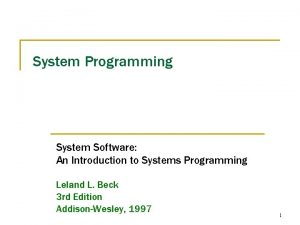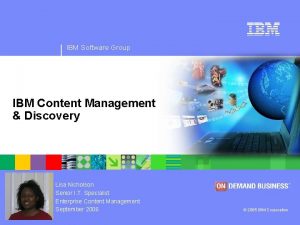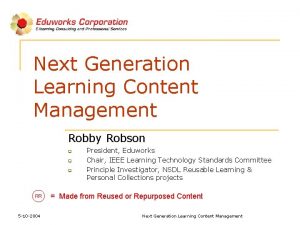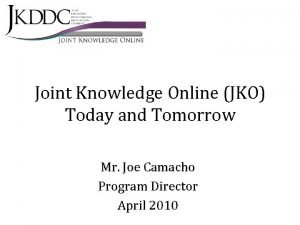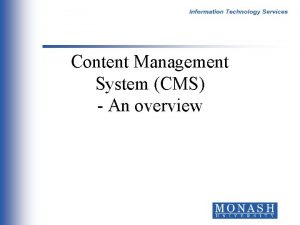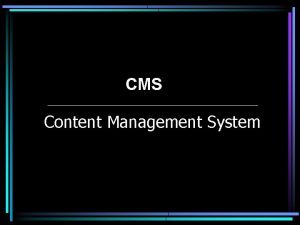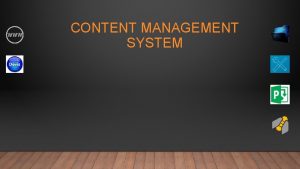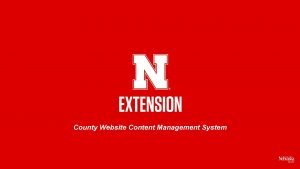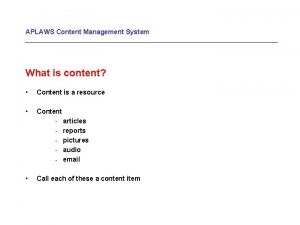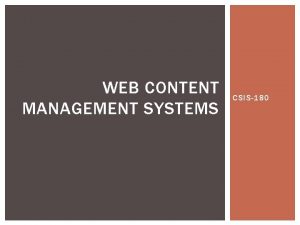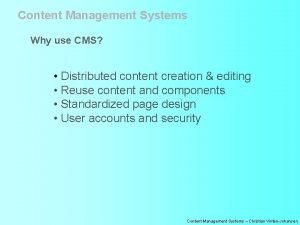Content Management Systems an introduction Content Management System










- Slides: 10

Content Management Systems - an introduction.

Content Management System ● A content management system is a computer application that allows publishing, editing and modifying content, organizing, deleting as well as maintenance from a central interface. ● CMSs have been available since the late 1990 s. ● CMSs are often used to run websites containing blogs, news, and shopping. ● Typically aim to avoid the need for hand coding.

Main features of a CMS features vary widely. Most CMS’s include the following. ● Web-based publishing, ● Format management, ● Revision control (version control), ● Indexing, search, and retrieval. Some content management systems also support the separation of content and presentation.

Content and Presentation The content management system (CMS) has two elements: ● Content management application (CMA) is the front-end user interface that allows a user, even with limited expertise, to add, modify and remove content from a Web site without the intervention of a Webmaster. ● Content delivery application (CDA) compiles that information and updates the Web site.

Web CMS ● A software system that provides website authoring, collaboration, and administration tools. ● Designed to allow users with little knowledge of web programming to create and manage website content with relative ease. ● Uses a content repository or a database to store page content, metadata, and other information assets. ● Has a presentation layer (template engine) to display the content to website visitors based on a set of templates. ● Uses server side caching to improve performance.

Capabilities of a CMS ● ● ● ● Automated templates Access control Scalable expansion Easily editable content Scalable feature sets Web standards upgrades Collaboration

Capabilities of a CMS ● ● ● ● Delegation Document management Workflow management Content virtualization Content syndication Multilingual Versioning

Advantages ● ● ● Low cost Easy customization Easy to use Workflow management Good For Search Engine Optimization

Disadvantages ● ● ● Cost of implementations Cost of maintenance Latency issues Tool mixing Security

Some Popular CMS ● Word. Press was the most popular content management system before 2014. ● Textpattern is one of the first open source CMS. ● Joomla! is a popular content management system. ● Drupal is the third most used CMS and originated before Word. Press and Joomla. ● Expression. Engine is in the top 5 most used CMSs. It is a commercial CMS ● Media. Wiki powers Wikipedia and related projects. ● Magnolia CMS. ● Cascade Server is popular among universities and enterprise scale organizations. ● e. Xo Platform Open Source Social CMS. ● Liferay Open Source Portal WCMS.
 Introduction to content management systems
Introduction to content management systems Sic programming examples
Sic programming examples Carrier content vs real content
Carrier content vs real content Static content vs dynamic content
Static content vs dynamic content Introduction to management information systems 5th edition
Introduction to management information systems 5th edition Ibm enterprise content management
Ibm enterprise content management Content management system
Content management system Learning content management system open source
Learning content management system open source Robby robson
Robby robson Joint knowledge online learning management system
Joint knowledge online learning management system Content management system project plan
Content management system project plan

